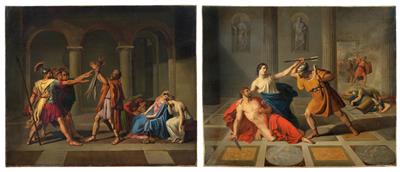School of Jacques-Louis David

(Paris 1748–1825 Brussels)
The Death of Alcibiades; and
The Oath of the Horatii,
oil on canvas, 64 x 77 cm and 63 x 75.5 cm, unframed, a pair (2)
Provenance:
Private European collection
The Oath of the Horatii repeats Jacques-Louis David’s celebrated composition (330 x 425 cm, Musée du Louvre, Paris, inv. no. 3692) painted in Rome in 1784 and exhibited at the Paris Salon following his return to France. The subject is taken from a Roman legend that relates to a tale from the reign of Tullo Ostilio (710–642 B.C.) in which, in order to reach a conclusive outcome of the war between Rome and Alba Longa, three brothers from Rome (the Orazi) fought other three brothers from Alba Longa (the Curazi). None of the Curazi survived, while of the three Orazi only one managed to claim victory for Rome.
The second composition also represents a classical subject: the Death of Alcibiades, who was an Athenian military leader, politician, orator and statesman, as well as a student of Socrates. Alcibiades was assassinated by the Spartans in his own home where he lived with his lover, Timandra, killed by a rain of arrows while he lunged at his assailants brandishing a dagger.
Jacques-Louis David championed Neoclassicism, which flourished in France during the late eighteenth and early nineteenth centuries. Exemplified by rigorous contours, sculpted forms, and polished surfaces; history paintings, such as the present were intended as moral examples. David painted in the service of the monarchy, radical revolutionaries, and an emperor; although his political allegiances shifted, he remained faithful to the tenets of Neoclassicism, which he transmitted to a generation of students, including François Gérard, Antoine-Jean Gros, Jean-Auguste-Dominique Ingres, and Anne-Louis Girodet-Trioson.
Before the Revolution, David’s major history paintings, though often relating to contemporary events, drew on subjects from ancient history in keeping with the tenets of the French Academy, which placed history painting at the top of a hierarchy of subjects while scenes from contemporary life were relegated to a lower order.
Specialist: Mark MacDonnell
 Mark MacDonnell
Mark MacDonnell
+43 1 515 60 403
mark.macdonnell@dorotheum.at
11.05.2022 - 16:00
- Estimate:
-
EUR 30,000.- to EUR 40,000.-
School of Jacques-Louis David
(Paris 1748–1825 Brussels)
The Death of Alcibiades; and
The Oath of the Horatii,
oil on canvas, 64 x 77 cm and 63 x 75.5 cm, unframed, a pair (2)
Provenance:
Private European collection
The Oath of the Horatii repeats Jacques-Louis David’s celebrated composition (330 x 425 cm, Musée du Louvre, Paris, inv. no. 3692) painted in Rome in 1784 and exhibited at the Paris Salon following his return to France. The subject is taken from a Roman legend that relates to a tale from the reign of Tullo Ostilio (710–642 B.C.) in which, in order to reach a conclusive outcome of the war between Rome and Alba Longa, three brothers from Rome (the Orazi) fought other three brothers from Alba Longa (the Curazi). None of the Curazi survived, while of the three Orazi only one managed to claim victory for Rome.
The second composition also represents a classical subject: the Death of Alcibiades, who was an Athenian military leader, politician, orator and statesman, as well as a student of Socrates. Alcibiades was assassinated by the Spartans in his own home where he lived with his lover, Timandra, killed by a rain of arrows while he lunged at his assailants brandishing a dagger.
Jacques-Louis David championed Neoclassicism, which flourished in France during the late eighteenth and early nineteenth centuries. Exemplified by rigorous contours, sculpted forms, and polished surfaces; history paintings, such as the present were intended as moral examples. David painted in the service of the monarchy, radical revolutionaries, and an emperor; although his political allegiances shifted, he remained faithful to the tenets of Neoclassicism, which he transmitted to a generation of students, including François Gérard, Antoine-Jean Gros, Jean-Auguste-Dominique Ingres, and Anne-Louis Girodet-Trioson.
Before the Revolution, David’s major history paintings, though often relating to contemporary events, drew on subjects from ancient history in keeping with the tenets of the French Academy, which placed history painting at the top of a hierarchy of subjects while scenes from contemporary life were relegated to a lower order.
Specialist: Mark MacDonnell
 Mark MacDonnell
Mark MacDonnell
+43 1 515 60 403
mark.macdonnell@dorotheum.at
|
Buyers hotline
Mon.-Fri.: 10.00am - 5.00pm
old.masters@dorotheum.at +43 1 515 60 403 |
| Auction: | Old Master Paintings I |
| Auction type: | Saleroom auction with Live Bidding |
| Date: | 11.05.2022 - 16:00 |
| Location: | Vienna | Palais Dorotheum |
| Exhibition: | 30.04. - 11.05.2022 |
